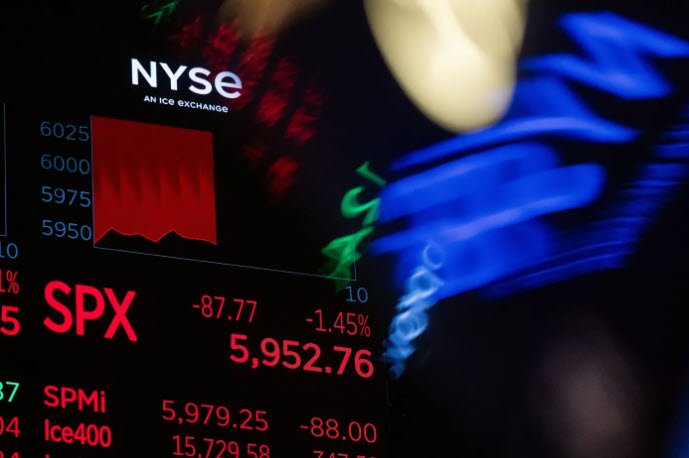This post was originally published on this site
Financial advisers who gathered at a conference in Miami last week offered tips on investment opportunities with US stocks lagging.
Photographer: Michael Nagle/Bloomberg
Takeaways
- Embrace international stocks, particularly in Europe and Japan, as they have performed well this year and have more room to run.
Summary by Bloomberg AI - Diversify portfolios by investing in bonds and international stocks, and consider exchange-traded funds focused on companies that grow their dividends.
Summary by Bloomberg AI - Mid-cap stocks and “boring bonds” are also attractive options, offering higher quality and more profitable companies, as well as a stable income stream.
Summary by Bloomberg AI
It was financial nerd heaven in Miami Beach — a roughly 2,500-strong crowd of advisers and industry professionals with answers to your every investing question.
Wondering how to transfer wealth effectively? How to scrutinize a private market investment? How to navigate inflation and global uncertainty? At the Future Proof Citywide conference earlier this week an answer was likely only a few strides away.
The vibe of the conference was upbeat, with a panel on Bitcoin by Strategy Chief Executive Officer Michael Saylor drawing the largest crowd. That was somewhat at odds with the mood in the market lately. Deep drops in the most high-profile tech stocks have frayed many investor nerves and portfolios as political uncertainty and recession fears reverberate through the economy.
The Bloomberg Magnificent 7 Total Return Index has fallen about 14% this year, and is down nearly 18% from a December peak. With tech stocks dragging down the S&P 500 index, investors have looked to diversify their portfolios. Here’s a small sampling of the investing opportunities discussed in Miami Beach, taken from panel discussions and sit-downs with investment professionals at the recent event.
Embrace Europe, Japan
While international stocks have performed well so far this year, there’s more room to run, according to Gabriela Santos, chief market strategist for the Americas at J.P. Morgan Asset Management. She pointed to the MSCI ACWI ex USA, a broad international index, where “the discount to the S&P 500 is now at 30% versus 40% to start the year, and 15% is the 20-year average.”
Santos considers the recent move into international stocks “a big realignment taking place in portfolios” that is being triggered by a correction on the Mag 7 stocks, as opposed to concerns about the US entering a recession.
Santos particularly likes Europe and Japan, which she said haven’t gotten enough attention from US investors. Financial stocks in Europe and Japan are attractive, given the end of deflation and the return of positive interest rates, said Santos. Within Europe, industrials are a focus given the massive increase in defense spending in Germany and broader Europe, she said. In Japan, an increase in wage growth and domestic consumption has her favoring domestic-oriented companies.
Diversify, Dividends
The current turmoil in the market presents an opportunity to get back to fundamentals, said Bryan Armour, Morningstar’s director of passive strategies.
“With US stocks as a percentage of portfolios at one of the highest levels ever, this is an excellent time for a more diversified portfolio,” Armour said. “That’s not to say to sell US stocks, but to diversify into bonds and international stock exposure.”
“We don’t know what’s going to happen, so don’t try to guess,” he added. “Just hold a diversified portfolio and live to fight another day. Be boring.”
A less risky pocket of the market investors could explore is exchange-traded funds focused on companies that grow their dividends, said Armour.
The Vanguard Dividend Appreciation ETF (VIG) “focuses on long-term dividend growers and cuts companies that have the highest dividend yields,” he said. (A high dividend can be a sign that a company is in financial trouble.) There’s an international version of the ETF (ticker: VIGI). Another choice is the Schwab US Dividend Equity ETF (SCHD), which focuses on dividend yield and quality.
Mid-Caps
The sweet spot for equities is mid-caps, according to Emily Roland, co-chief investment officer at John Hancock Investment Management.
“The stocks are trading at a 30% discount to large-cap stocks and are higher quality than small caps – more profitable, better earnings, more cash on the balance sheet and lower debt levels,” she said.
“The challenge for large-cap stocks is valuations at 20 times forward earnings,” Roland added. “It is going to be tough to get more multiple expansion from here, and multiple expansion has been the key driver of equity returns the last two years.”
Buy ‘Boring Bonds’
Along with mid-cap stocks, bonds are also a favored asset class for Roland.
“What’s unappreciated is boring bonds,” she said. “They’re mispriced and deserve more attention.”
While Roland doesn’t think bond yields should be as high as they are, she likes the “income cushion” they provide investors today. She favors intermediate maturities of seven to 10 years.
“With the aggregate bond index yield about 4.7% and investment-grade corporate bonds around 5.25% — I’ll take that all day long,” she said. “Lock in an income stream for years. You get a third of the risk of equities.”
For those who want to invest in a bond fund, a recent Morningstar report analyzed where actively managed funds have the best odds of outperforming passive peers. Active bond funds had a far better showing than US stock-pickers, according to the report.
“Active bond managers can take more risk in a smart way to have a more durable edge,” said Morningstar’s Armour. “If you go active, mind your costs and pick an area where there’s the best chance to be successful.”
(Ritholtz Wealth Management is an investor in events company Future Proof and a co-creator of Future Proof events. Barry Ritholtz hosts Bloomberg’s Masters of Business podcast.)
© 2025 Bloomberg L.P.
